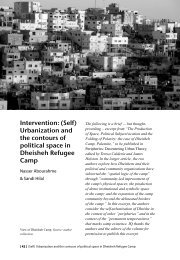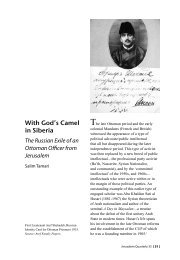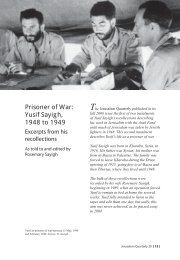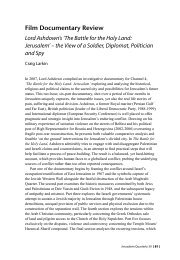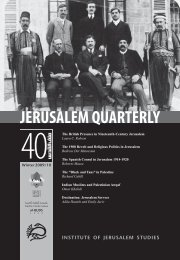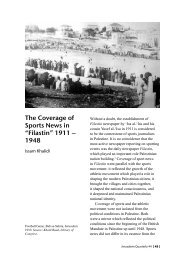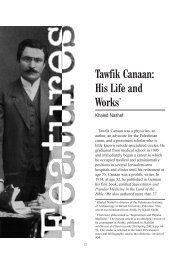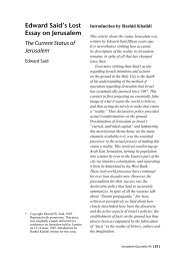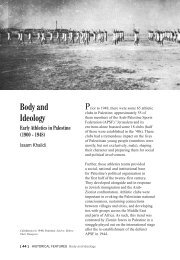Jurji Habib Hanania - Institute for Palestine Studies
Jurji Habib Hanania - Institute for Palestine Studies
Jurji Habib Hanania - Institute for Palestine Studies
Create successful ePaper yourself
Turn your PDF publications into a flip-book with our unique Google optimized e-Paper software.
<strong>Jurji</strong> also had a sister, Irene, nine years<br />
his junior, who married a member<br />
of another old Jerusalem family, the<br />
Zakarias, and who also died during<br />
World War I.<br />
<strong>Jurji</strong> himself undertook elementary<br />
and secondary education at the Bishop<br />
Gobat School in Jerusalem, but<br />
beyond that he was a self-educated<br />
man. He read extensively and ended<br />
up mastering what he referred to<br />
as his seven-and-a-half languages:<br />
Arabic, Turkish, Greek, French,<br />
English, German, Russian and “a little<br />
Hebrew”.<br />
<strong>Jurji</strong> was married to Aniseh Farradj,<br />
who also belonged to a prominent<br />
Jerusalem family. Of her siblings, her<br />
sister Marie married Jiryes Elissa,<br />
who became publisher of a newspaper<br />
in Jaffa and three of whose children<br />
later carried on with the newspaper<br />
business. Another of Marie’s sons,<br />
Said, became a well-known and<br />
highly respected poet in Jordan.<br />
Aniseh’s two brothers followed civic<br />
rather than literary careers–her brother<br />
Yaqub, a prominent leader of the<br />
Palestinian national movement in the<br />
1930s, rising to the post of deputy<br />
mayor of Jerusalem, and her brother<br />
Dimitri becoming the district governor<br />
of Hebron and later of Ramallah.<br />
<strong>Jurji</strong> and his family, with his Greek mother Katingo<br />
seated on the right (circa 1904).<br />
Source: Collection of the author<br />
<strong>Jurji</strong>’s daughters, Futini (left) and Katherine (right),<br />
circa 1909. Source: Collection of the author<br />
<strong>Jurji</strong> and Aniseh lived in a house next to the printing press. Aniseh, a well-educated<br />
woman, was familiar with the daily running of the business and often lent a hand at the<br />
press when needed. They had four surviving children. The eldest was a girl, Katherine,<br />
followed by another girl, Futini, and two boys, Issa and Damian. <strong>Jurji</strong> was proud to<br />
send his daughters to the best available school <strong>for</strong> girls in Jerusalem and made sure<br />
they would be daily accompanied by an escort carrying their books there and back.<br />
[ 54 ] HISTORICAL FEATURES History of the Earliest Press in <strong>Palestine</strong>, 1908-1914



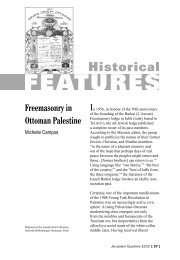
![In Search of Jerusalem Airport [pdf] - Jerusalem Quarterly](https://img.yumpu.com/49007736/1/180x260/in-search-of-jerusalem-airport-pdf-jerusalem-quarterly.jpg?quality=85)
